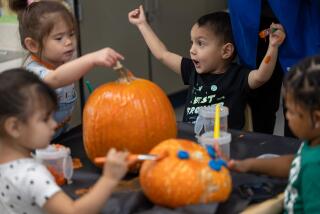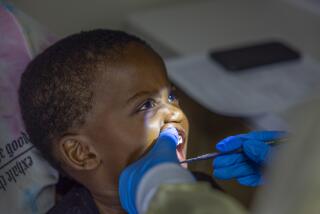How to Find the Right Care?
- Share via
Nothing can stifle a working parent’s productivity faster than nagging concerns about day-care arrangements. Is my child safe? Is he happy? Is she getting enough loving and careful attention? In an emergency, can the caregiver take appropriate measures?
Here’s a question-and-answer guide to choosing a situation that’s best for you and your little one:
Q. What types of day-care options are available?
A. Here are four basic alternatives: child-care centers, family child care, home-care providers and nanny or in-home care.
In California, child-care centers (sometimes called nursery schools or preschools) and family child-care operations require licenses from the state Department of Social Services. (Licensing establishes rules for training of staff and limits how many children can be cared for in a given program. A caveat: Licensing does not ensure quality; rather, it merely indicates that a center has met basic guidelines for health and safety.)
Child-care centers, facilities built specifically for the care of children, can be large or small and are run independently or by a company, church or other organization. Staff members must have training in early-childhood education. Family child care is offered in the home of the caregiver, where a sole provider can care for four children younger than 2 or for six children of varying ages. With an adult assistant, that number can rise to 12 children. Many in family child care have training in early-childhood education, but that is not a requirement.
Both child-care centers and family child-care providers may voluntarily seek accreditation. Centers are evaluated by the National Assn. for the Education of Young Children in Washington, and family child-care providers, by the National Assn. of Family Child Care, in Des Moines. A recent two-year study at 92 child-care centers in California indicated that accredited centers tend to offer high-quality care, but researchers cautioned parents not to take accreditation alone as a sign of excellence. Of the nation’s 97,000 child-care centers, just 5,000 are accredited.
Home-care providers, who do not need a license, may care in their
home for the children from one other family besides their own. Nanny care, also unregulated, is provided in the child’s home.
Q: Let’s focus on child-care centers and family child care. Is one better than the other?
A: No. Each has advantages and disadvantages, depending on the child’s needs and the parents’ work and financial situations. For example, center-based care is dependable, but hours are defined and often inflexible (many centers charge by-the-minute late fees). Family care, which is more home-like than a center, could be disrupted if the provider became ill. Parents often strongly prefer one or the other, but “our goal is to have the parent be open-minded,” said Jennifer Montgomery, resource and referral manager for Connections for Children.
Q: How can I learn about centers or family-based operations near me?
A: Each California county has a resource and referral agency to direct parents. Ten such agencies exist in Los Angeles County. They include Child and Family Services in Los Angeles [(213) 427-2700], which covers downtown, Beverly Hills, Hollywood and Silver Lake; Connections for Children in Santa Monica [(310) 452-3202], which serves the western portion of the county from Agoura Hills on the north to Hermosa Beach; and Mexican-American Opportunity Foundation [(213) 890-9616], which serves Commerce, Monterey Park and other communities near downtown. To find a referral agency near you, call (800) 543-7793.
Q: Should I choose a facility near home or near work?
A: That’s a tough one, and experts’ opinions vary widely. “What I’ve seen over the years is that parents with infants like to have them close by,” said Kathleen Malaske-Samu, child-care coordinator for Los Angeles County. “When the kids are older, they prefer having them in the community where they live.”
Two-career couples with offices in different directions often find it convenient to have the child near home in case one parent has to dash to the center in an emergency. Some parents, on the other hand, enjoy conversing with kids during the drive to and from work.
Madeleine Stoner, a professor at USC’s School of Social Work, said she enjoyed commuting with her two children when they were young. “The time in the car was extremely valuable mother-child time,” she said. “We’d play word and spelling games, talk about what happened at school or listen to music.”
As far as Malaske-Samu is concerned, “it all boils down [for parents] to, when the Big One comes, will we be close enough to get to our little ones? Whenever we have a big jolt, there’s a bigger interest in trying to put kids closer.”
Q: OK. So I have the locations of some centers near me. What should I look for when I visit them?
A: One important feature that parents should seek out is an open-door policy. Make sure that the center operator or family-care provider welcomes parents to pop in. Beyond that, here are several things to put on a checklist:
* Is the facility clean and inviting to children and adults?
* Are classrooms clean and orderly, with a variety of activity areas?
* Are materials arranged so that children can help themselves?
* Do children appear happy and involved?
* Are there safe outdoor areas?
* Is climbing equipment both safe and challenging?
* Is there a place for naps and quiet play?
* How is the interaction between adults and children?
* Are there enough adults for the children that you see?
* Is the TV or VCR on too often? An hour or so in the late afternoon isn’t bad, Stoner of USC said, but too much video watching can stifle creativity.
* What sort of backup plan is in place should a care provider or staff member become ill?
* Does the center have several infant walkers or swings? If so, that might indicate that infants do not get held enough.
* Is lunch provided? What sorts of snacks are offered?
Q: How much should I expect to pay?
A: For family child care in L.A. County, the average weekly cost for children younger than 2 is $125; for older children, it’s $100. At centers, there is a wide range, with monthly infant care running $600 to $825 and monthly care for preschoolers costing $425 to $600.
Q: What are some warning signs that a situation is no longer appropriate for my child?
A: Be on the alert for any changes in behavior, such as withdrawal, or signs of resistance about going to the day-care location. If a child starts to act out at home, he might need more stimulation. Children who become bored tend also to become aggressive. As your child continues to grow and learn and master different levels of development, she should continually be challenged.
As Connections for Children notes in its guidelines for parents, everyone has different notions of how best to rear children. Seek a caregiver whose philosophy, values and discipline techniques are compatible with yours. Above all, trust your gut feelings.



